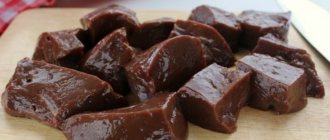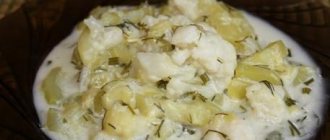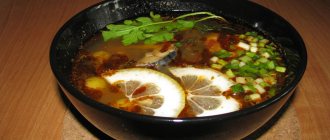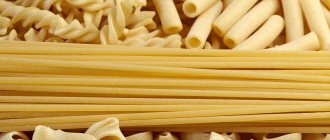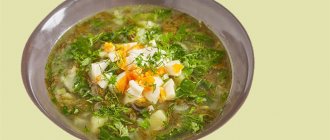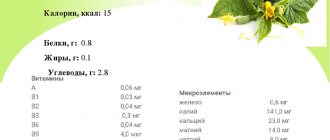Calorie content of stewed carrots with onions per 100 grams
The calorie content of stewed carrots and onions per 100 grams is only 30 kcal. Per 100 gram serving:
- 1.23 g protein;
- 0.12 g fat;
- 6.9 g carbohydrates.
To prepare you need:
- peel and chop into small pieces 75 g of onion;
- fry the onion in a frying pan without oil;
- peel and grate 0.3 kg of fresh carrots;
- mix onions and carrots, add a few tablespoons of drinking water, simmer the dish under a closed lid for 15 minutes;
- salt the prepared stewed carrots and onions to taste.
Due to the absence of oil in the recipe, the dish is low in calories and contains virtually no fat. Such stewed vegetables can be prepared while dieting and losing weight. In case of exacerbations of diseases of the gastrointestinal tract and pancreas, the possibility of including stewed carrots and onions in the diet is discussed with the attending physician. Due to onions, such dishes may in some cases be contraindicated.
Lose weight on carrots: how?
This root vegetable can truly form the basis of an excellent diet. After all, 100 grams of vegetables contain more than 80 grams of water: if you want it, you won’t gain weight.
Most often, carrot mono-diets last from 1 to 3 days. During this period, you can eat only carrots in any form. Of course, spices, oil, fried, sweet, flour products will have to be excluded from the diet.
The carrot diet, designed for 10 days, includes a salad of fresh grated vegetables and its juice as main dishes. Boiled carrots, fresh vegetables and fruits, fermented milk products, and whole grain cereals can dilute the diet.
The effect of carrot diets is based on the fact that this root vegetable contains few calories, quickly fills you up, and besides, if you eat fresh, peeled, but not grated carrots, then you will not be able to eat more than a kilogram per day: it is not at all easy to chew a hard root vegetable .
Calorie content of stewed cabbage with carrots and onions per 100 grams
Calorie content of stewed cabbage with carrots and onions per 100 grams is 43 kcal. In 100 g of this dish:
- 1.38 g protein;
- 2.23 g fat;
- 5.3 g carbohydrates.
- chop 200 g of onions into small pieces, grate 120 g of fresh carrots;
- onions are fried in vegetable oil until golden brown;
- Grated carrots are lightly fried with fried onions;
- shred 800 g of white cabbage;
- cabbage mixed with frying, diced 350 g tomatoes;
- The vegetable mixture is salted to taste and simmered under a closed lid for a quarter of an hour.
Recipe Stewed carrots with onions. Calorie, chemical composition and nutritional value.
Nutritional value and chemical composition of “Carrots stewed with onions.”
The table shows the nutritional content (calories, proteins, fats, carbohydrates, vitamins and minerals) per 100 grams of edible portion.
| Nutrient | Quantity | Norm** | % of the norm in 100 g | % of the norm in 100 kcal | 100% normal |
| Calorie content | 96.4 kcal | 1684 kcal | 5.7% | 5.9% | 1747 g |
| Squirrels | 1.5 g | 76 g | 2% | 2.1% | 5067 g |
| Fats | 6.3 g | 60 g | 10.5% | 10.9% | 952 g |
| Carbohydrates | 8.2 g | 211 g | 3.9% | 4% | 2573 g |
| Organic acids | 0.3 g | ~ | |||
| Alimentary fiber | 3.2 g | 20 g | 16% | 16.6% | 625 g |
| Water | 80.1 g | 2400 g | 3.3% | 3.4% | 2996 g |
| Ash | 1.079 g | ~ | |||
| Vitamins | |||||
| Vitamin A, RE | 990.5 mcg | 900 mcg | 110.1% | 114.2% | 91 g |
| beta carotene | 5.944 mg | 5 mg | 118.9% | 123.3% | 84 g |
| Vitamin B1, thiamine | 0.055 mg | 1.5 mg | 3.7% | 3.8% | 2727 g |
| Vitamin B2, riboflavin | 0.041 mg | 1.8 mg | 2.3% | 2.4% | 4390 g |
| Vitamin B4, choline | 8.47 mg | 500 mg | 1.7% | 1.8% | 5903 g |
| Vitamin B5, pantothenic | 0.199 mg | 5 mg | 4% | 4.1% | 2513 g |
| Vitamin B6, pyridoxine | 0.144 mg | 2 mg | 7.2% | 7.5% | 1389 g |
| Vitamin B9, folates | 10.399 mcg | 400 mcg | 2.6% | 2.7% | 3847 g |
| Vitamin C, ascorbic acid | 3.52 mg | 90 mg | 3.9% | 4% | 2557 g |
| Vitamin E, alpha tocopherol, TE | 3.018 mg | 15 mg | 20.1% | 20.9% | 497 g |
| Vitamin H, biotin | 0.884 mcg | 50 mcg | 1.8% | 1.9% | 5656 g |
| Vitamin K, phylloquinone | 7.5 mcg | 120 mcg | 6.3% | 6.5% | 1600 g |
| Vitamin RR, NE | 0.7832 mg | 20 mg | 3.9% | 4% | 2554 g |
| Niacin | 0.545 mg | ~ | |||
| Macronutrients | |||||
| Potassium, K | 207.78 mg | 2500 mg | 8.3% | 8.6% | 1203 g |
| Calcium, Ca | 33.53 mg | 1000 mg | 3.4% | 3.5% | 2982 g |
| Silicon, Si | 16.204 mg | 30 mg | 54% | 56% | 185 g |
| Magnesium, Mg | 27.82 mg | 400 mg | 7% | 7.3% | 1438 g |
| Sodium, Na | 12.77 mg | 1300 mg | 1% | 1% | 10180 g |
| Sera, S | 44.45 mg | 1000 mg | 4.4% | 4.6% | 2250 g |
| Phosphorus, Ph | 63.4 mg | 800 mg | 7.9% | 8.2% | 1262 g |
| Chlorine, Cl | 48.84 mg | 2300 mg | 2.1% | 2.2% | 4709 g |
| Microelements | |||||
| Aluminium, Al | 422.1 mcg | ~ | |||
| Bor, B | 231.1 mcg | ~ | |||
| Vanadium, V | 51.61 mcg | ~ | |||
| Iron, Fe | 0.851 mg | 18 mg | 4.7% | 4.9% | 2115 g |
| Yod, I | 4.51 mcg | 150 mcg | 3% | 3.1% | 3326 g |
| Cobalt, Co | 4.213 mcg | 10 mcg | 42.1% | 43.7% | 237 g |
| Lithium, Li | 3.128 mcg | ~ | |||
| Manganese, Mn | 0.2503 mg | 2 mg | 12.5% | 13% | 799 g |
| Copper, Cu | 95.67 mcg | 1000 mcg | 9.6% | 10% | 1045 g |
| Molybdenum, Mo | 10.593 mcg | 70 mcg | 15.1% | 15.7% | 661 g |
| Nickel, Ni | 5.03 mcg | ~ | |||
| Rubidium, Rb | 314.1 mcg | ~ | |||
| Selenium, Se | 0.369 mcg | 55 mcg | 0.7% | 0.7% | 14905 g |
| Strontium, Sr | 4.54 mcg | ~ | |||
| Fluorine, F | 58.7 mcg | 4000 mcg | 1.5% | 1.6% | 6814 g |
| Chromium, Cr | 2.83 mcg | 50 mcg | 5.7% | 5.9% | 1767 |
| Zinc, Zn | 0.7476 mg | 12 mg | 6.2% | 6.4% | 1605 g |
| Digestible carbohydrates | |||||
| Starch and dextrins | 0.165 g | ~ | |||
| Mono- and disaccharides (sugars) | 8.3 g | max 100 g | |||
| Glucose (dextrose) | 2.128 g | ~ | |||
| Sucrose | 5.947 g | ~ | |||
| Fructose | 1.282 g | ~ | |||
| Essential amino acids | 0.344 g | ~ | |||
| Arginine* | 0.123 g | ~ | |||
| Valin | 0.038 g | ~ | |||
| Histidine* | 0.016 g | ~ | |||
| Isoleucine | 0.044 g | ~ | |||
| Leucine | 0.055 g | ~ | |||
| Lysine | 0.058 g | ~ | |||
| Methionine | 0.011 g | ~ | |||
| Methionine + Cysteine | 0.023 g | ~ | |||
| Threonine | 0.042 g | ~ | |||
| Tryptophan | 0.017 g | ~ | |||
| Phenylalanine | 0.042 g | ~ | |||
| Phenylalanine+Tyrosine | 0.07 g | ~ | |||
| Nonessential amino acids | 0.731 g | ~ | |||
| Alanin | 0.062 g | ~ | |||
| Aspartic acid | 0.115 g | ~ | |||
| Glycine | 0.041 g | ~ | |||
| Glutamic acid | 0.262 g | ~ | |||
| Proline | 0.035 g | ~ | |||
| Serin | 0.034 g | ~ | |||
| Tyrosine | 0.028 g | ~ | |||
| Cysteine | 0.014 g | ~ | |||
| Sterols (sterols) | |||||
| beta sitosterol | 12.195 mg | ~ | |||
| Saturated fatty acids | |||||
| Saturated fatty acids | 0.7 g | max 18.7 g | |||
| 16:0 Palmitinaya | 0.378 g | ~ | |||
| 18:0 Stearic | 0.25 g | ~ | |||
| 20:0 Arakhinovaya | 0.018 g | ~ | |||
| 22:0 Begenovaya | 0.043 g | ~ | |||
| Monounsaturated fatty acids | 1.451 g | from 18.8 to 48.8 g | 7.7% | 8% | |
| 18:1 Oleic (omega-9) | 1.445 g | ~ | |||
| Polyunsaturated fatty acids | 3.963 g | from 11.2 to 20.6 g | 35.4% | 36.7% | |
| 18:2 Linolevaya | 3.646 g | ~ | |||
| Omega-6 fatty acids | 3.7 g | from 4.7 to 16.8 g | 78.7% | 81.6% |
The energy value of stewed carrots with onions is 96.4 kcal.
Primary Source: Created in the application by the user. Read more.
** This table shows the average levels of vitamins and minerals for an adult. If you want to know the norms taking into account your gender, age and other factors, then use the “My Healthy Diet” application.
health-diet.ru
Calorie content of stewed zucchini with carrots and onions per 100 grams
Calorie content of stewed zucchini with carrots and onions per 100 grams is 38 kcal. Per 100 gram serving:
- 1 g protein;
- 1.15 g fat;
- 5.9 g carbohydrates.
- 4 zucchini, thoroughly washed, dried and cut into cubes;
- 2 medium carrots, grated on a coarse grater;
- finely chop 2 onions;
- onions and carrots are fried in vegetable oil;
- Add chopped zucchini and 120 g of tomato paste to the frying. The dish is stewed under a closed lid for a quarter of an hour;
- Salt is added to the prepared vegetables to taste.
Recipe Carrots stewed with onions. Calorie, chemical composition and nutritional value.
Nutritional value and chemical composition of “Carrots stewed with onions.”
The table shows the nutritional content (calories, proteins, fats, carbohydrates, vitamins and minerals) per 100 grams of edible portion.
| Nutrient | Quantity | Norm** | % of the norm in 100 g | % of the norm in 100 kcal | 100% normal |
| Calorie content | 57.6 kcal | 1684 kcal | 3.4% | 5.9% | 2924 g |
| Squirrels | 1.9 g | 76 g | 2.5% | 4.3% | 4000 g |
| Fats | 2.5 g | 60 g | 4.2% | 7.3% | 2400 g |
| Carbohydrates | 7.4 g | 211 g | 3.5% | 6.1% | 2851 g |
| Organic acids | 23.3 g | ~ | |||
| Alimentary fiber | 2.4 g | 20 g | 12% | 20.8% | 833 g |
| Water | 83.7 g | 2400 g | 3.5% | 6.1% | 2867 g |
| Ash | 1 g | ~ | |||
| Vitamins | |||||
| Vitamin A, RE | 4700 mcg | 900 mcg | 522.2% | 906.6% | 19 g |
| Retinol | 4.7 mg | ~ | |||
| Vitamin B1, thiamine | 0.05 mg | 1.5 mg | 3.3% | 5.7% | 3000 g |
| Vitamin B2, riboflavin | 0.07 mg | 1.8 mg | 3.9% | 6.8% | 2571 g |
| Vitamin B4, choline | 6.1 mg | 500 mg | 1.2% | 2.1% | 8197 g |
| Vitamin B5, pantothenic | 0.2 mg | 5 mg | 4% | 6.9% | 2500 g |
| Vitamin B6, pyridoxine | 0.1 mg | 2 mg | 5% | 8.7% | 2000 g |
| Vitamin B9, folates | 11.2 mcg | 400 mcg | 2.8% | 4.9% | 3571 g |
| Vitamin B12, cobalamin | 0.09 mcg | 3 mcg | 3% | 5.2% | 3333 g |
| Vitamin C, ascorbic acid | 7.5 mg | 90 mg | 8.3% | 14.4% | 1200 g |
| Vitamin D, calciferol | 0.01 mcg | 10 mcg | 0.1% | 0.2% | 100000 g |
| Vitamin E, alpha tocopherol, TE | 0.5 mg | 15 mg | 3.3% | 5.7% | 3000 g |
| Vitamin H, biotin | 0.9 mcg | 50 mcg | 1.8% | 3.1% | 5556 g |
| Vitamin RR, NE | 0.9154 mg | 20 mg | 4.6% | 8% | 2185 g |
| Niacin | 0.6 mg | ~ | |||
| Macronutrients | |||||
| Potassium, K | 197.7 mg | 2500 mg | 7.9% | 13.7% | 1265 g |
| Calcium, Ca | 55.3 mg | 1000 mg | 5.5% | 9.5% | 1808 |
| Silicon, Si | 0.09 mg | 30 mg | 0.3% | 0.5% | 33333 g |
| Magnesium, Mg | 28.6 mg | 400 mg | 7.2% | 12.5% | 1399 g |
| Sodium, Na | 26.8 mg | 1300 mg | 2.1% | 3.6% | 4851 g |
| Sera, S | 19.1 mg | 1000 mg | 1.9% | 3.3% | 5236 g |
| Phosphorus, Ph | 60.2 mg | 800 mg | 7.5% | 13% | 1329 g |
| Chlorine, Cl | 417.4 mg | 2300 mg | 18.1% | 31.4% | 551 g |
| Microelements | |||||
| Aluminium, Al | 256.5 mcg | ~ | |||
| Bor, B | 133.8 mcg | ~ | |||
| Vanadium, V | 56.9 mcg | ~ | |||
| Iron, Fe | 0.6 mg | 18 mg | 3.3% | 5.7% | 3000 g |
| Yod, I | 5 mcg | 150 mcg | 3.3% | 5.7% | 3000 g |
| Cobalt, Co | 2 mcg | 10 mcg | 20% | 34.7% | 500 g |
| Lithium, Li | 3.3 mcg | ~ | |||
| Manganese, Mn | 0.1514 mg | 2 mg | 7.6% | 13.2% | 1321 g |
| Copper, Cu | 60 mcg | 1000 mcg | 6% | 10.4% | 1667 g |
| Molybdenum, Mo | 13.1 mcg | 70 mcg | 18.7% | 32.5% | 534 g |
| Nickel, Ni | 3.7 mcg | ~ | |||
| Tin, Sn | 2.9 mcg | ~ | |||
| Rubidium, Rb | 52.1 mcg | ~ | |||
| Selenium, Se | 0.6 mcg | 55 mcg | 1.1% | 1.9% | 9167 g |
| Strontium, Sr | 3.6 mcg | ~ | |||
| Titanium, Ti | 0.2 mcg | ~ | |||
| Fluorine, F | 38.6 mcg | 4000 mcg | 1% | 1.7% | 10363 g |
| Chromium, Cr | 2.4 mcg | 50 mcg | 4.8% | 8.3% | 2083 g |
| Zinc, Zn | 0.4182 mg | 12 mg | 3.5% | 6.1% | 2869 g |
| Digestible carbohydrates | |||||
| Starch and dextrins | 1.6 g | ~ | |||
| Mono- and disaccharides (sugars) | 5.7 g | max 100 g |
The energy value of carrots stewed with onions is 57.6 kcal.
Main source: Internet. Read more.
** This table shows the average levels of vitamins and minerals for an adult. If you want to know the norms taking into account your gender, age and other factors, then use the “My Healthy Diet” application.
health-diet.ru
The benefits of stewed carrots
The beneficial properties of stewed carrots are:
- such dishes have low calorie content, therefore they are indicated for inclusion in the diet during dieting and weight loss;
- when stewed for a short time, carrots retain most of the vitamins and minerals, including enriched with vitamins A, B, C, D, E, minerals calcium, potassium, phosphorus, iron, magnesium, manganese;
- due to its pronounced antioxidant properties, stewed carrots are recommended to be included in the diet for the prevention of cancer;
- stewed carrots have an enveloping effect, so they are useful for irritation of the stomach and intestinal mucosa;
- the saturation of stewed carrots with dietary fiber allows it to be used to cleanse the body of toxins and waste;
- Carrot juice released when vegetables are stewed is useful for preventing vascular and heart diseases, preventing vitamin deficiency, kidney and liver diseases.
What are the benefits of carrots
Among the positive properties of such familiar and accessible food it is worth noting:
- beneficial effects on the eyes;
- prevention of vitamin deficiency;
- improved vision;
- normalization of metabolism;
- strengthening tooth enamel;
- ensuring skin elasticity and firmness;
- rejuvenating effect.
The vegetable ensures optimal development and growth of the young body and is responsible for the proper absorption of protein. Carrots help normalize a person’s condition in case of diseases of the cardiovascular system, energize, give strength and vigor.
Photo source: shutterstock.com
Including carrots in your daily diet speeds up the fat breakdown mechanisms. It also improves the condition of hair and nails, has a beneficial effect on the nervous system, and ensures high-quality blood clotting. This tasty and vibrant vegetable helps with poor health, is useful for anemia, and prolongs youth.
Carrots have an antiseptic effect, tones and provides a good mood. The root vegetable speeds up metabolism and is responsible for a beautiful, fresh skin tone. Good for bones, nerve fibers, teeth. Carrots are responsible for strengthening and growing muscle tissue, strengthening the immune system, and reducing the concentration of bad cholesterol in the blood.

Photo source: shutterstock.com
This food has a choleretic, analgesic, anthelmintic, anti-inflammatory, and mineralizing effect. Promotes healing of abrasions and wounds. It is also useful to eat carrots during bronchitis. The disease will go away faster.
The harm of stewed carrots
The harm of stewed carrots manifests itself in cases of individual intolerance to the product or the occurrence of allergic reactions. If you overeat such dishes, you may encounter problems with stool, flatulence, and bloating.
If you want to lose weight, we recommend that you eat stewed carrots without oil. The calorie content of such dishes is several times lower.
Stewed vegetables with the addition of large amounts of salt are contraindicated if you are prone to swelling.
SUBSCRIBE TO SITE UPDATES
How to stew carrots
There are some nuances in preparing and cooking carrots:
- A new kitchen sponge with a hard abrasive side will help remove soil from the root vegetable.
- For stewing, it is better to use a frying pan with a high side, a cauldron or a slow cooker and be sure to add oil.
- The larger the carrots are cut, the longer the stewing. The process takes about 30-40 minutes.
- Carrots stewed in milk, sour cream or cream will turn out much more tender than using water.
Carrots - calories per 100 grams
Carrots are extremely healthy, nutritious, and at the same time low in calories. Its energy value per 100 grams is only 32 Kcal . It contains only 1.3 g of protein, 0.1 g of fat, and 6.9 g of carbohydrates. This calorie content of carrots, if consumed raw regularly, will prevent you from gaining excess weight.

Since ancient times, carrots have been considered a kind of symbol of longevity. When the beta-carotene it contains enters the body, it is converted into vitamin A, which improves vision. The root vegetable is rich in magnesium, calcium, iodine, and manganese. It strengthens the immune system thanks to vitamins B, C and E. Carrots and carrot juice can be considered an analgesic, anti-inflammatory, wound healing agent that serves as an antiseptic. This miraculous vegetable is recommended for the following diseases:
- hearts;
- anemia;
- asthma;
- tuberculosis;
- pneumonia;
- kidney and liver diseases;
- gastritis, etc.
Fresh carrots relieve fatigue, increase appetite, and restore a healthy complexion. And most importantly, the low calorie content of carrots allows you to get rid of excess weight. Introducing carrots into your diet will improve metabolism, which, in turn, will help break down fat deposits.

Recipe for carrots stewed with onions. Calorie, chemical composition and nutritional value.
Nutritional value and chemical composition of “stewed carrots with onions”.
The table shows the nutritional content (calories, proteins, fats, carbohydrates, vitamins and minerals) per 100 grams of edible portion.
| Nutrient | Quantity | Norm** | % of the norm in 100 g | % of the norm in 100 kcal | 100% normal |
| Calorie content | 73.8 kcal | 1684 kcal | 4.4% | 6% | 2282 g |
| Squirrels | 1.3 g | 76 g | 1.7% | 2.3% | 5846 g |
| Fats | 4.5 g | 60 g | 7.5% | 10.2% | 1333 g |
| Carbohydrates | 6.8 g | 211 g | 3.2% | 4.3% | 3103 g |
| Organic acids | 0.3 g | ~ | |||
| Alimentary fiber | 2.5 g | 20 g | 12.5% | 16.9% | 800 g |
| Water | 83 g | 2400 g | 3.5% | 4.7% | 2892 g |
| Ash | 0.9121 g | ~ | |||
| Vitamins | |||||
| Vitamin A, RE | 1224.2 mcg | 900 mcg | 136% | 184.3% | 74 g |
| beta carotene | 7.345 mg | 5 mg | 146.9% | 199.1% | 68 g |
| Vitamin B1, thiamine | 0.048 mg | 1.5 mg | 3.2% | 4.3% | 3125 g |
| Vitamin B2, riboflavin | 0.043 mg | 1.8 mg | 2.4% | 3.3% | 4186 g |
| Vitamin B5, pantothenic | 0.198 mg | 5 mg | 4% | 5.4% | 2525 g |
| Vitamin B6, pyridoxine | 0.121 mg | 2 mg | 6.1% | 8.3% | 1653 g |
| Vitamin B9, folates | 8.582 mcg | 400 mcg | 2.1% | 2.8% | 4661 g |
| Vitamin C, ascorbic acid | 3.16 mg | 90 mg | 3.5% | 4.7% | 2848 g |
| Vitamin E, alpha tocopherol, TE | 2.247 mg | 15 mg | 15% | 20.3% | 668 g |
| Vitamin H, biotin | 0.665 mcg | 50 mcg | 1.3% | 1.8% | 7519 g |
| Vitamin K, phylloquinone | 8.5 mcg | 120 mcg | 7.1% | 9.6% | 1412 g |
| Vitamin RR, NE | 0.7656 mg | 20 mg | 3.8% | 5.1% | 2612 g |
| Niacin | 0.594 mg | ~ | |||
| Macronutrients | |||||
| Potassium, K | 176.23 mg | 2500 mg | 7% | 9.5% | 1419 g |
| Calcium, Ca | 27.6 mg | 1000 mg | 2.8% | 3.8% | 3623 g |
| Magnesium, Mg | 28.01 mg | 400 mg | 7% | 9.5% | 1428 g |
| Sodium, Na | 14.11 mg | 1300 mg | 1.1% | 1.5% | 9213 g |
| Sera, S | 20.36 mg | 1000 mg | 2% | 2.7% | 4912 g |
| Phosphorus, Ph | 51.3 mg | 800 mg | 6.4% | 8.7% | 1559 g |
| Chlorine, Cl | 8.09 mg | 2300 mg | 0.4% | 0.5% | 28430 g |
| Microelements | |||||
| Aluminium, Al | 331.8 mcg | ~ | |||
| Bor, B | 61.9 mcg | ~ | |||
| Iron, Fe | 0.68 mg | 18 mg | 3.8% | 5.1% | 2647 g |
| Yod, I | 0.93 mcg | 150 mcg | 0.6% | 0.8% | 16129 g |
| Cobalt, Co | 1.546 mcg | 10 mcg | 15.5% | 21% | 647 g |
| Lithium, Li | 3.866 mcg | ~ | |||
| Manganese, Mn | 0.0715 mg | 2 mg | 3.6% | 4.9% | 2797 g |
| Copper, Cu | 27.99 mcg | 1000 mcg | 2.8% | 3.8% | 3573 g |
| Nickel, Ni | 0.928 mcg | ~ | |||
| Rubidium, Rb | 147.2 mcg | ~ | |||
| Selenium, Se | 0.064 mcg | 55 mcg | 0.1% | 0.1% | 85938 g |
| Fluorine, F | 35.36 mcg | 4000 mcg | 0.9% | 1.2% | 11312 g |
| Chromium, Cr | 0.62 mcg | 50 mcg | 1.2% | 1.6% | 8065 g |
| Zinc, Zn | 0.2629 mg | 12 mg | 2.2% | 3% | 4564 g |
| Digestible carbohydrates | |||||
| Starch and dextrins | 0.16 g | ~ | |||
| Mono- and disaccharides (sugars) | 6.7 g | max 100 g | |||
| Glucose (dextrose) | 2.0129 g | ~ | |||
| Sucrose | 4.2655 g | ~ | |||
| Fructose | 1.0155 g | ~ | |||
| Essential amino acids | 0.2895 g | ~ | |||
| Arginine* | 0.0759 g | ~ | |||
| Valin | 0.0354 g | ~ | |||
| Histidine* | 0.0134 g | ~ | |||
| Isoleucine | 0.0349 g | ~ | |||
| Leucine | 0.0438 g | ~ | |||
| Lysine | 0.043 g | ~ | |||
| Methionine | 0.0089 g | ~ | |||
| Methionine + Cysteine | 0.0191 g | ~ | |||
| Threonine | 0.033 g | ~ | |||
| Tryptophan | 0.0113 g | ~ | |||
| Phenylalanine | 0.0327 g | ~ | |||
| Phenylalanine+Tyrosine | 0.0539 g | ~ | |||
| Nonessential amino acids | 0.5884 g | ~ | |||
| Alanin | 0.0489 g | ~ | |||
| Aspartic acid | 0.1086 g | ~ | |||
| Glycine | 0.0314 g | ~ | |||
| Glutamic acid | 0.2195 g | ~ | |||
| Proline | 0.0286 g | ~ | |||
| Serin | 0.0296 g | ~ | |||
| Tyrosine | 0.0209 g | ~ | |||
| Cysteine | 0.0118 g | ~ | |||
| Sterols (sterols) | |||||
| beta sitosterol | 8.7629 mg | ~ | |||
| Saturated fatty acids | |||||
| Saturated fatty acids | 0.5 g | max 18.7 g | |||
| 16:0 Palmitinaya | 0.2716 g | ~ | |||
| 18:0 Stearic | 0.1796 g | ~ | |||
| 20:0 Arakhinovaya | 0.0131 g | ~ | |||
| 22:0 Begenovaya | 0.0307 g | ~ | |||
| Monounsaturated fatty acids | 1.0428 g | from 18.8 to 48.8 g | 5.5% | 7.5% | |
| 18:1 Oleic (omega-9) | 1.0384 g | ~ | |||
| Polyunsaturated fatty acids | 2.6201 g | from 11.2 to 20.6 g | 23.4% | 31.7% | |
| 18:2 Linolevaya | 2.6201 g | ~ |
The energy value of carrots stewed with onions is 73.8 kcal.
Primary Source: Created in the application by the user. Read more.
** This table shows the average levels of vitamins and minerals for an adult. If you want to know the norms taking into account your gender, age and other factors, then use the “My Healthy Diet” application.
health-diet.ru
How many calories are in boiled beans in water?

You can prepare many delicious and nutritious dishes from different varieties of beans. Not all people know that beans are commonly called meat due to their high protein content of plant origin. That is why such products are frequent guests on vegetarian tables.
So, a person eats dry bean fruits and green beans. The beans are canned and cooked in various ways, but most often they are roasted. If we talk about the raw beans that we are used to buying, then their nutritional value will vary from 93 to 102 kilocalories, depending on the variety.
By the way, white beans are slightly higher in calories than red beans. But low-calorie foods include beans and asparagus. Their calorie content ranges from 24 to 47 kilocalories per 100 g.
Of course, no one will eat beans raw. Most often it is boiled and then added to their gastronomic masterpieces. How many calories are in boiled red beans? The nutritional value of a 100-gram serving of boiled beans is approximately 123 kilocalories. How many calories are in boiled green beans? In this form, beans can be called a dietary product, because one hundred grams contains only 35 kilocalories.
We found out how many calories are in boiled green beans. But housewives do not always boil beans. They are often fried and stewed. When fried, green beans will be much higher in calories due to the addition of fat or oil. Its nutritional value is about 94 kilocalories. But boiled beans, subjected to additional frying, will be even higher in calories. A 100-gram serving contains up to 145 kilocalories.
The calorie content of stewed beans can vary from 75 to 111 kilocalories. Another popular product is canned beans. Its calorie content is 16 kilocalories for green beans, and 99 for white and red beans.
The value of plant-based meat
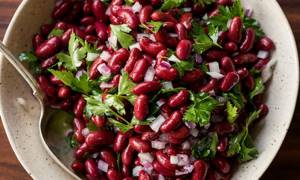
Approximately 20% of the total mass of beans is protein. That is why nutritionists often put this product on the same level as meat. Almost 60% comes from carbohydrates. But they cannot be called empty. The body is charged with energy, and the person feels full for a long time. If you eat one hundred-gram serving, you need to walk for half an hour or ride a bike for a quarter of an hour to burn off the calories.
On a note! Beans are incredibly healthy for humans because they contain a number of vital amino acids.
Bean side dish “Unusual”
Kidney beans can be used to make a number of nutritious and amazing-tasting treats. Some people add beans to soup, others like spicy lobio, most people choose this crop for preparing hearty side dishes. We suggest you cook beans in a new way. Gastronomic pleasure is guaranteed.
On a note! To reduce the duration of heat treatment, you need to soak the beans for at least 10-12 hours. The water needs to be changed periodically, otherwise the beans will spoil and develop an unpleasant odor.
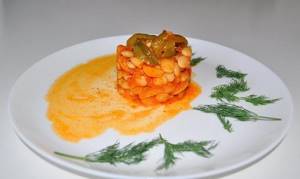
Ingredients:
- dry white beans – 350 g;
- carrots - two root vegetables;
- sweet bell pepper – three pieces;
- fresh tomatoes – 1 kg;
- refined olive fruit oil – ¼ cup;
- saffron – one pinch;
- garlic - head;
- salt, ground paprika.
Preparation:
- After soaking, rinse the beans thoroughly and place them in a bowl with a thick bottom. You can also use a slow cooker for cooking.

- Wash the tomatoes thoroughly and cut into pieces. Don't forget to remove the stalk.
- Transfer the crushed tomatoes to a container in a food processor or blender.

- Grind to obtain natural juice with pulp.
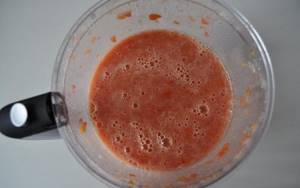
- Pour freshly squeezed juice over the beans. We activate the “Quenching” program mode for a couple of hours.
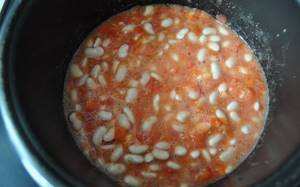
- Let's prepare all the necessary spices. In addition to those listed, you can add something of your own.
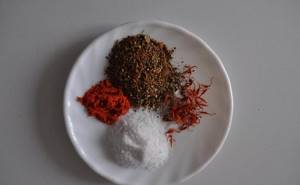
- After one hour has passed since the start of cooking the beans, add salt and seasonings to them. Mix well.

- Chop the vegetables.
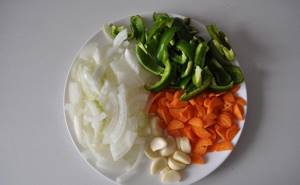
- First, saute the chopped onion in refined olive oil until an amber crust appears.

- Then add carrots to it. By the way, it is better to cut the carrots into slices rather than grate them.

- Cut about three garlic cloves into slices and add to the vegetables.
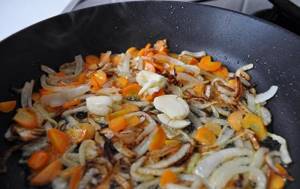
- Transfer the fried vegetables to the beans.
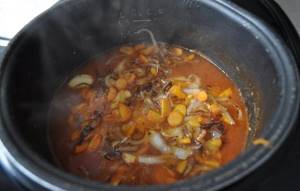
- Do not fry fresh sweet peppers. Cut it into slices and add to the rest of the ingredients.
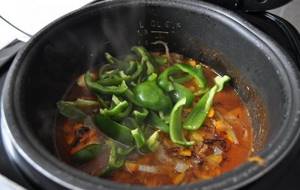
- Pass the remaining garlic cloves through a press and add to the beans.
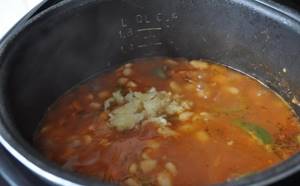
- Mix everything and prepare the side dish until the end of the specified program.
- You can serve these beans as an independent dish or add meat, cooked in the oven or baked on the grill.
Which method of use should you choose?

Carrots can be used not only as an additive to food or a component of various salads, but also as an independent dish. Carrot juice is also very useful, which is an excellent aperitif, as it can increase appetite - just do not forget to control the amount of food consumed after it.
It is better to eat raw for weight loss
Carrot salad diet

By choosing this diet, you can lose up to 3 kg in 4-5 days. The point of the diet is to eat carrot salad throughout the day. At the same time, you can cook it in portions or once for the whole day. The diet goes like this:
- In total, you need to eat 1 kg of carrots per day, divided into 4 meals. The preparation method is quite simple: grate the carrots, add the juice of one lemon and 1 tablespoon each of honey and vegetable oil.
- With each meal you can allow yourself one fruit of your choice: kiwi, apple, pomegranate, orange or grapefruit.
- To the morning portion you can add half a glass of milk or kefir and one tablespoon of 10% sour cream. Milk fats will help ensure that all the beneficial substances found in carrots are fully absorbed.
- You can drink unsweetened green tea and still mineral water throughout the day.
- It is allowed to replace dinner with carrot and fruit juice.
- For the entire period of the diet, salt, sugar, spices and spices are completely excluded from the diet.
- On the fourth day, you can add 200 g of boiled lean meat and 2 baked or boiled potatoes to lunch.
- The fifth day is considered the day of leaving the diet, when foods with minimal fat content are introduced into the diet.
- You need to limit yourself to fatty foods, fried foods, baked goods and sweets for another 10 days, otherwise the weight may return very quickly. A prerequisite is the presence of carrot salad on the menu.
If desired, you can repeat this diet monthly.
How to lose weight deliciously

It is not necessary to force yourself to eat one carrot. According to nutritionists, to lose 3-4 kg, you just need to include carrots in your diet. The menu can be very different; not only dishes from carrot soup to cutlets and salads in combination with other vegetables, fruits, dairy products, but also freshly squeezed carrot juice will be useful.
